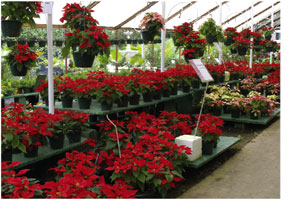10/25/2010
Poinsettias: The Final Step–Shipping
Dr. P. Allen Hammer

Poinsettia growers have a responsibility for the post-production longevity of the plants we offer to consumers. Growers can’t afford to simply be happy to have the plants out of the greenhouse door. Satisfied poinsettia consumers make for repeat customers. As a poinsettia producer and marketer, you can do a great deal to maintain the potential postharvest beauty and longevity built into the modern poinsettia cultivars.
At the same time, you can easily reduce the postharvest life of the poinsettias you handle. The grower’s responsibility in postharvest care is to provide the best poinsettia possible at the proper stage of development, free of insects and diseases, and with root medium low in soluble salts. Too young, underdeveloped bracts will never develop good color in the postharvest environment. Pink bracts on red cultivars result when plants leave the production environment too early. Too old bracts on plants held too long in warm greenhouses will also provide less beauty for the consumer.
Fertilizer salts should be reduced before shipping; however, it’s not desirable to completely eliminate fertilizer application. Just reduce the rate to 1/2 or 1/4 the rate used during early production. Completely eliminating fertilizer application can result in lower leaf yellowing in the post-harvest environment. Poinsettias can also receive chilling injury when exposed to 50F (10C) or less for as short as a two-hour period. Chilling injury can cause epinasty as well as leaf loss under the most severe case.
Transporting plants in unheated trucks in the north and uncooled trucks in the south can significantly reduce poinsettia quality. A general guideline is that poinsettias do much better when placed in a uniform non-stressful environment, avoiding too high or too low extremes in temperature, light and water.
Although bract necrosis (also called bract edge burn) is not a problem in modern poinsettia cultivars, I have observed some re-occurrence in recent years. Growers experiencing bract necrosis can apply weekly sprays of 400 ppm calcium from calcium chloride beginning at first color to eliminate the problem. Spray the bract leaves to runoff, making sure all the bract tissue is covered. A wetting agent is not recommended for fear of phytotoxicity, although other researchers have recommended a wetting agent to improve coverage. Growers who have experienced any bract necrosis should spray plants with calcium as insurance. Use a “re-agent” grade of the chemical calcium chloride dihydrate (CaCl2 • 2 H2O) to make a 400 ppm calcium spray solution. (1.47 g of calcium chloride dihydrate/liter water or 55.6 g/10 gal. water or 1.96 oz./10 gal. water)
The poinsettia grower should also provide handling instructions to retailers. Those instructions can include:
- Upon receiving plants, unpack and unsleeve them immediately. Poinsettias left in the sleeve become droopy. This epinasty is often caused by ethylene production from the sleeving process. The longer poinsettias are sleeved and the higher the temperature is above 65F (18C), the greater the droopiness problem. The plants generally recover from epinasty in a couple of days when placed in a lighted area at 65F to 75F (18C to 23C) if the sleeving period was longer than a couple of days.
- Poinsettias should be placed in bright light at 60F to 65F (15C to 18C). They should not receive direct sunlight under postharvest conditions.
- The plants should be placed out of hot or cold drafts. A heat duct or outside door should not expose the plants to sudden changes in temperature. At no time should poinsettias be stored in an unheated or uncooled area.
Poinsettias are fragile. Rough handling will bruise the bracts and cause stem and leaf breakage. Poinsettia plants cannot be handled like hardgoods. Also, be sure to provide adequate spacing in the display area. Plants should not be spaced so close together that the bracts from one plant rub against the bracts of an adjacent plant. And even if you think you have no or little control on how the retailer handles the poinsettia plants, written handling instructions included with shipments will never hurt.
GT
Dr. P. Allen Hammer is a retired professor of floriculture at Purdue University, West Lafayette, Indiana, and is now in product development and support for Dümmen USA.